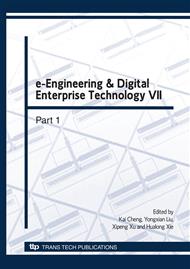p.431
p.436
p.441
p.445
p.450
p.456
p.462
p.466
p.471
Theoretical Modeling and Experimental Verification of Surface Roughness in Abrasive Jet Finishing
Abstract:
Based on the modeling and experiments concerning the surface roughness in abrasive jet finishing with grinding wheel as restraint, the effect of abrasive size, abrasive fluid concentration, machining cycle, wheel velocity and carrier fluid on machined surface quality was investigated. Surface grinder M7120 was employed in a jet machining experiment conducted with W18Cr4V and 40Cr materials, profilometer TALYSURF was used to measure the micro geometrical parameters after machining, and SEM was used to observe surface micro-morphology. Experimental results show that with W7 Al2O3 powder at the mass fraction of 10% and antirust lubricating liquid being adopted in jet machining for 20 to 30 cycles, not only high surface shape precision can be kept or obtained, but also defect-free machined surface with the roughness of Ra0.15~1.6µm can be obtained with high efficiency. Experimental observation and experimental results proved that the experimental results agree well with a mechanism-based machining model.
Info:
Periodical:
Pages:
450-455
Citation:
Online since:
October 2009
Authors:
Keywords:
Price:
Сopyright:
© 2009 Trans Tech Publications Ltd. All Rights Reserved
Share:
Citation:


